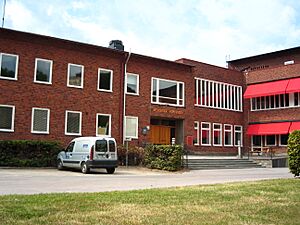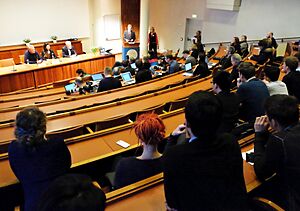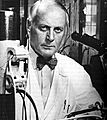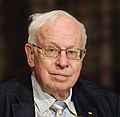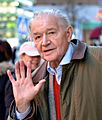Karolinska Institute facts for kids
|
Karolinska Institutet
|
|
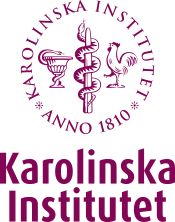 |
|
|
Former names
|
Kongl. Carolinska Medico Chirurgiska Institutet (1817–1968) |
|---|---|
| Motto | Att förbättra människors hälsa (Swedish) |
|
Motto in English
|
To improve human health |
| Type | Public |
| Established | 1810 |
| Endowment | 576,1 million EUR (2010) |
| Budget | SEK 6.67 billion |
| Vice-Chancellor | Annika Östman Wernerson |
|
Administrative staff
|
4,820 (2016) |
| Students | 6,481 (FTE, 2020) |
| 2,039 (2020) | |
| Location |
,
,
Sweden
59°20′56″N 18°01′36″E / 59.34889°N 18.02667°E |
| Campus | Solna (Main) and Flemingsberg |
| Colors | KI Plum |
The Karolinska Institute (often called KI) is a famous medical university in Solna, Sweden. It is known worldwide for its amazing medical research. The special group called the Nobel Assembly at the Karolinska Institute chooses who wins the Nobel Prize in Physiology or Medicine each year. This group is made up of fifty professors from the university. The current leader of the Karolinska Institute is Annika Östman Wernerson, who started her role in March 2023.
The Karolinska Institute was started in 1810 in Stockholm. Later, its main campus moved to Solna, which is just outside Stockholm. A second campus was opened more recently in Flemingsberg, south of Stockholm. The institute also has a special center for repairing the body, with locations in Stockholm and Hong Kong.
The Karolinska Institute is Sweden's third oldest medical school. It is a very important place for learning and research in Sweden. About 30% of all medical training and over 40% of all medical and life science research in Sweden happens here. It also gets about one-third of all the money Sweden gives for medical research.
The Karolinska University Hospital works closely with the university. It is a place where students learn and doctors do research. Together, they form a big center for health science. Most medical programs are taught in Swedish. However, many PhD projects are done in English. The institute's name comes from the "Caroleans," who were soldiers from Sweden's past.
Contents
Nobel Prize Winners from KI
Many brilliant scientists from the Karolinska Institute have won the Nobel Prize. Here are some of them:
- 1955 Hugo Theorell was the first from KI to win a Nobel Prize. He won for his discoveries about how certain enzymes work in the body.
- 1967 Ragnar Granit received the Nobel Prize for his work on how our eyes see. He studied how nerve cells in the eye react to light and colors.
- 1970 Ulf von Euler won the Nobel Prize for finding out how nerve cells send messages. He discovered how chemicals are stored and released in nerves.
- 1981 Torsten Wiesel and David H. Hubel shared the Nobel Prize. They discovered how our visual system processes information to help us see.
- 1982 Sune Bergström and Bengt Samuelsson also shared the Nobel Prize. They won for their discoveries about prostaglandins, which are important substances in the body.
What the Seal Symbols Mean
The Karolinska Institute's seal has some interesting symbols. Each one has a special meaning related to health and medicine.
Rod of Asclepius
This symbol looks like a snake wrapped around a staff. It is named after Aesculapius, who was the ancient Greek god of medicine. People believed he could heal others, and he was often shown with a snake. Over time, the snake wrapped around his staff became a symbol of healing.
Snake Bowl
The snake bowl is linked to Hygieia, who was the goddess of health and Asclepius's daughter. The snake eating from her bowl was seen as a sign of good luck and health. It does not mean the snake put venom into the bowl.
Cockerel
The cockerel (a rooster) is a symbol of new life and recovery. In ancient times, people who got better from an illness would offer a cockerel to Asclepius. The famous Greek philosopher Socrates mentioned this in his last words. He said, "Crito, we owe a cockerel to Asclepius. Do pay it. Don't forget." This showed his belief in paying respect after healing.
Education at KI
The Karolinska Institute offers many different medical programs in Sweden. Many of these programs include hands-on training in hospitals. The nearby Karolinska University Hospital and other hospitals in Stockholm are very important for students' learning.
About 6,000 full-time students are taking courses at the Karolinska Institute. Each year, 20 high school students from all over Sweden are chosen for a special 7-week summer research program. This program, called "SoFo," teaches them about biomedical science.
The Nobel Assembly at KI
The Nobel Assembly at the Karolinska Institute is a special group that decides who wins the Nobel Prize in Physiology or Medicine. This group has fifty professors from the Karolinska Institute. They are chosen by the university's faculty.
Even though it's at the Karolinska Institute, the Nobel Assembly is a private organization. This means it's not officially part of the government-run university. This setup helps them follow the rules of the Nobel Foundation. For example, they can keep all their discussions and documents secret for at least 50 years. This ensures the prize decisions are fair and private.
The Nobel Committee at the Karolinska Institute helps the Assembly. It has five members who collect nominations and check the nominees. This committee recommends who should win, but the final decision is always made by the Nobel Assembly.
Famous People from KI
Many important scientists and doctors have studied or worked at the Karolinska Institute.
- Jöns Jakob Berzelius (1779–1848) was a professor at KI. He created modern chemical notation and is known as one of the fathers of modern chemistry. He also discovered elements like silicon and selenium.
- Carl Gustaf Mosander (1792–1858) was a chemist and a student of Berzelius. He discovered the elements lanthanum, erbium, and terbium.
- Axel Key (1832–1901) was a pathologist and a leader of the institute. He started what is now the Journal of Internal Medicine.
- Karl Oskar Medin (1847–1928) was a children's doctor. He was famous for his studies on poliomyelitis (polio).
- Ivar Wickman (1872–1914) was also a children's doctor and an expert on polio.
- Nanna Svartz (1890–1986) was the first female professor at the Karolinska Institute. She was a researcher in stomach diseases and a rheumatologist.
- Ulf von Euler (1905–1983) was a physiologist and won the Nobel Prize in Physiology or Medicine in 1970.
- Herbert Olivecrona (1891–1980) is known as the founder of neurosurgery in Sweden.
- Ragnar Granit (1900–1991) won the Nobel Prize in Physiology or Medicine in 1967.
- Hugo Theorell (1903–1982) won the Nobel Prize in Physiology or Medicine in 1955.
- Lars Leksell (1907–1986) was a doctor who invented radiosurgery and the Gamma Knife.
- Sune Bergström (1916–2004) won the Nobel Prize in Physiology or Medicine in 1982.
- Pehr Edman (1916–1977) was a chemist known for the Edman degradation method.
- Sven Ivar Seldinger (1921–1998) was a radiologist who invented the Seldinger technique.
- Torsten Wiesel (born 1924) won the Nobel Prize in Physiology or Medicine in 1981.
- Bengt I. Samuelsson (born 1934) won the Nobel Prize in Physiology or Medicine in 1982.
- Tomas Lindahl won the Nobel Prize in Chemistry in 2015 for his cancer research.
- Lennart Nilsson (1922–2017) was a famous photojournalist and documentarian.
- Johan Harmenberg (born 1954) is an Olympic champion fencer.
See also
 In Spanish: Instituto Karolinska para niños
In Spanish: Instituto Karolinska para niños
- Karolinska Institute Prize for Research in Medical Education
- Sahlgrenska University Hospital
- Royal Institute of Technology
- Stockholm School of Economics
- Stockholm University
- The New Karolinska Solna University Hospital, opened in 2015
- S*, a collaboration between seven universities and the Karolinska Institute


